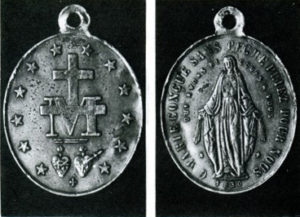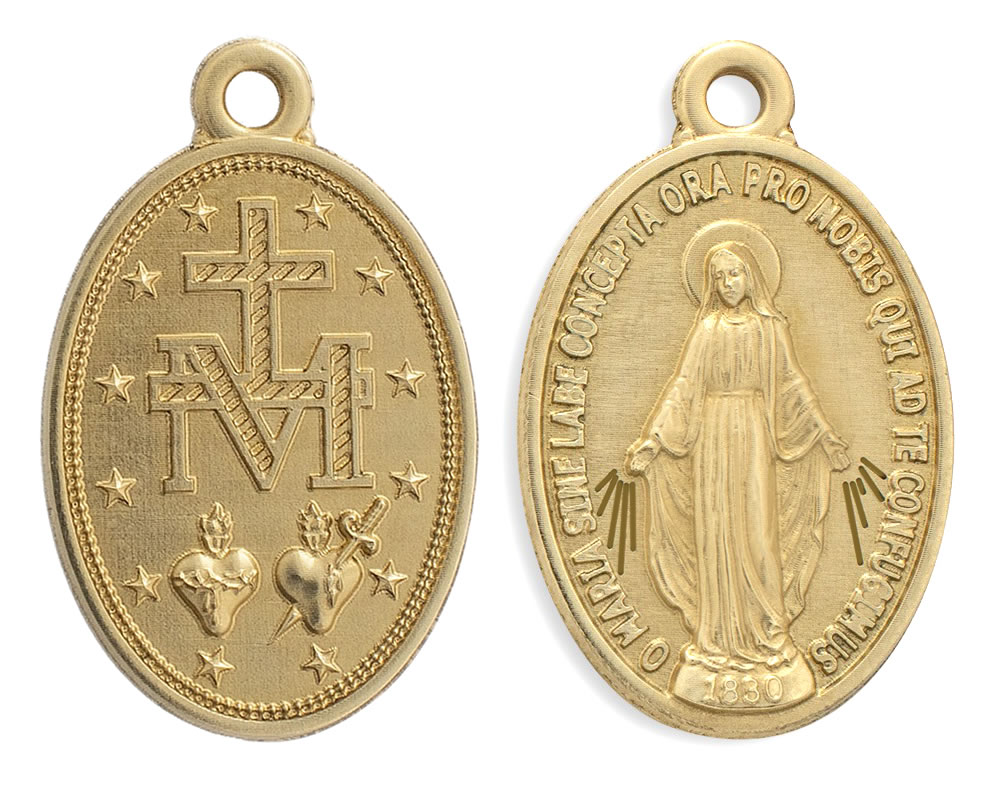Time and time again we are confronted with the criticism that our medals are not genuine and therefore invalid because the number of points on the stars is wrong or because some other detail is not pressed authentically. The most important arguments pertain to the form and arrangement of the stars, the omission of some words of the ejaculatory prayer, as well as some other details (the date, the snake, etc.).
Father Karl Stehlin made the following statement in this regard:

St. Catherine Labouré confided the apparitions of 1830 solely to her confessor, Fr. Aladel, and it is through him that we have the complete report of the occurrences in the Rue de Bac. I have a copy of the first edition of Fr. Aladel’s book, written in 1845. It contains a description of the apparitions and several miracles which have occurred throughout the world because of the medal.
During the appar
ition of November 27, 1830, an oval frame appeared around the Mother of God, on which was written in gold: “O Mary, conceived without sin, pray for us who have recourse to Thee.” At the same time, Catherine heard the words: “Have a medal struck upon this model. All who wear it will receive great graces. Graces will abound for those who wear it with confidence.”
And then she saw the letter M, surmounted by a cross, with a crossbar beneath it, and underneath, the Sacred Hearts of Jesus and Mary; the former surrounded by a crown of thorns, the latter pierced by a sword.
Here we have the essential elements which are necessary in order for this medal to be called truly the “Miraculous Medal”.
Certainly, we find the most faithful and best realization of it in the Rue de Bac itself, where the same medal has been struck for many years, though only in French. However there are a few additions there which weren’t included in the original text, e.g the date: 1830.
The important thing is Our Lady’s comment that the medal should be struck according to Catherine’s vision. Now it’s not easy to reproduce such a grand vision on paper, in the same way that the statues of Our Lady of Lourdes and Fatima vary in details, but all are recognized as such.
Fr. Aladel also understood it this way, since in the same book you find several engravings and pictures which portray the medal very differently: with one star, with many stars, sometimes with six points, sometimes with five.

The following argument arises: if one would wish to strike the medal exactly the way St. Catherine saw it, then the prayer would have to always appear in French. However, from the very beginning, the Church allowed the translation into other languages. Now the French language is very short and concise. If one wishes to translate the ejaculatory prayer from the Rue de Bac word for word, then it will end up considerably longer in most languages, which poses a big problem for the stamping: either the text will be illegible or it will have to be abbreviated slightly, which is exactly what has always been done. These versions of the Miraculous Medal are also ecclesiastically approved.
Perhaps we need to look deeper into the problematic “fake Medals” accusation.
The medal is namely a sacramental, meaning a holy sign, a symbolic object through which grace is conveyed.
What is the special grace of the Miraculous Medal?

It is the spiritual presence and powerful efficacy of the Immaculata in our life: by means of the medal, we are united in our daily routine with our heavenly Mother and we receive her special assistance.
This sensorial sign should remind us of the grand and glorious mysteries of Mary. Indeed, the medal is a reminder of all of the great truths and the “Glories of Mary”. But it’s not possible to press all the great mysteries of the Immaculata into a tiny little medal. The medal is at the same time a visible reminder as well as an admonition: “Think about me, I am here with you!” – And through the medal, the IMMACULATA stands before me, in order that I might honour and love her and listen to her directions.
In a similar way, we honour the statue of Our Lady of Fatima, but no one would think upon doing so that all of the mysteries, wonders and occurrences of Fatima are expressed somewhere in the statue. The statue is the reminder of the power and efficacious love of the Immaculate Heart of Mary, not the table of contents of everything that occurred in Fatima.
Singapore, March 3, 2016


